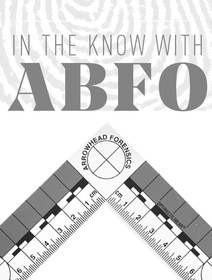Posted by EL on 22nd May 2019
Proper Use of ABFO Scales
In crime scene photography, the proof is in the details. A great way to get detailed, comparison grade photographs of evidence is to use a photo macrographic scale. In this article, we will be detailing ABFO NO.2 photo macrographic scales. These come in multiple colors, which include 18% gray, white with 18% gray accents and black which are ideal with proper camera settings.
ABFO stands for “American Board of Forensic Odontologists.” The scale was developed by this board in order to properly photograph bite mark evidence for comparison of the human mouth.
Bite mark evidence can be transient in nature and may change or even disappear before it can be observed in the lab. Therefore, it is important to get a useable macro (1:1 or life size) image of the bite mark that can be used in comparison examinations as soon after the bite mark is made as possible.
It is also beneficial to take photos of the bite mark over time, especially when the mark is on human skin, as the bruising or healing may cause the mark to look different.
Bite mark evidence can be located and documented on human skin or in a variety of other substances to include food, pens or pencils, wood, nylon, paper, etc.
It is important to document the bite mark photographically before processing the evidence in any other way. Then, after photographing it swabs and casts can be taken of the bite mark.
In order to properly photograph the bite mark, the scale needs to be placed at the same level of the bite mark, meaning it can’t be too much higher or too much lower than the surface of the bite mark. Otherwise, angular distortion can be created and the measurements will not be accurate.
INCORRECT PLACEMENT OF SCALE

CORRECT PLACEMENT OF SCALE
The camera also needs to be held at a 90 degree angle to the bite mark, so that again, it properly depicts the bite mark.
INCORRECT PLACEMENT OF CAMERA IN REFERENCE TO BITE MARK

CORRECT PLACEMENT OF CAMERA IN REFERENCE TO BITE MARK

It is best to take the camera off of automatic settings and manually adjust them. Uncompressed format photos should be taken to give the most comparable 1:1 detail (TIFF, RAW or NEF-never JPEG).
The ISO setting should be set at 100-200, with an F stop of F/16 or F/22, with a varying shutter speed. It helps to start with a test shutter speed and speed it up or slow it down depending on the results. If possible, a shorter macrographic lens gives the best results-usually a 50mm to 100mm length lens.
Bracketing is also a good way to catch shots that show the most detail in the impression. With bracketing, you can set the camera to take photos 1-3 stops above and below normal exposure. This will give you a range of darker and lighter photos to see what creates the best lighting for the markings.
A tripod is recommended when photographing the evidence, so that the same plane is achieved in each photo and so there is no shaking of the camera while the shutter is open, which causes blurring. Lighting should also be used from multiple angles (at least four) to achieve ideal exposure and is very important to achieve comparison grade photos. This can include an external flash with or without a sync cord or a flashlight.
If there are obvious upper and lower teeth marks, each one should be photographed separately because they will generally be on different planes.
ABFO NO.2 photo macrographic scales are often used for non-bite mark evidence as well.
As with bite mark evidence, the scale should be placed on the same level as the evidence being photographed, and the photo should be taken perpendicular to the evidence to achieve proper measurements.
As its name implies, it is best suited for macro photography, which means a comparison grade photo, but can also be used in larger scale photos to give reference to the evidence in the scene.
The same camera settings can be used for comparison photos of evidence that are used for bite mark evidence, with multiple lighting angles used to achieve the best photos.
Finally, it is very important that the scales be well maintained. If the scale is bent, it can also cause distortion in the photos. So, the scale should be stored in an area it can be laid flat where it is not susceptible to bending.
REFERENCES:
https://piel-l.org/blog/wp-content/uploads/2014/06/Como-realizar-buenas-fotos-en-dermatologia.pdf
https://www.ncbi.nlm.nih.gov/pmc/articles/PMC5734855/
 ABOUT THE AUTHOR:
ABOUT THE AUTHOR:
Emily Lewey is a former IAI certified Crime Scene Investigator. She obtained her associate’s degree in Law Enforcement and her bachelor’s degree in Criminal Justice Administration with a minor in Crime Scene Investigation from Missouri Southern State University. Emily worked for the Lee’s Summit, MO PD as their first and only CSI for 4 years, then for the Kansas City, MO PD Crime Lab for 1 and a half years before coming to Arrowhead Forensics. She worked a wide variety of scenes ranging from property crimes to homicides and is proficient in a variety of processing techniques. She continues to stay educated in the ever-changing world of forensics and crime scene work.



